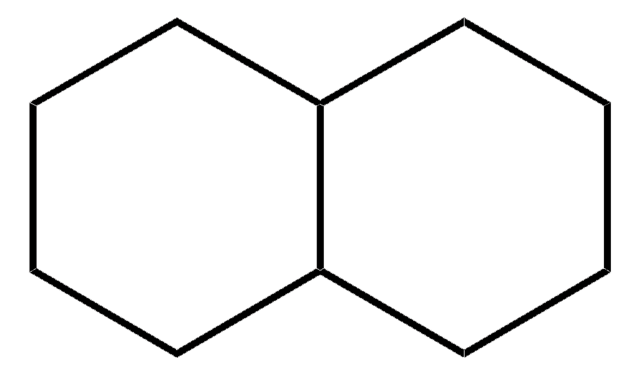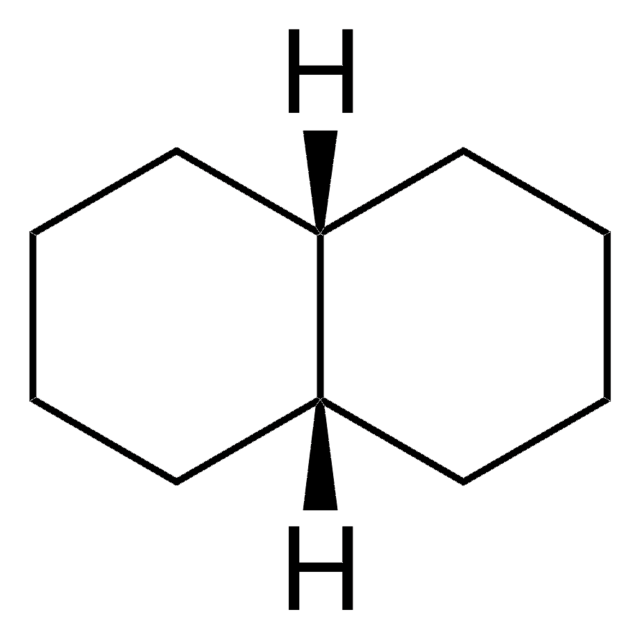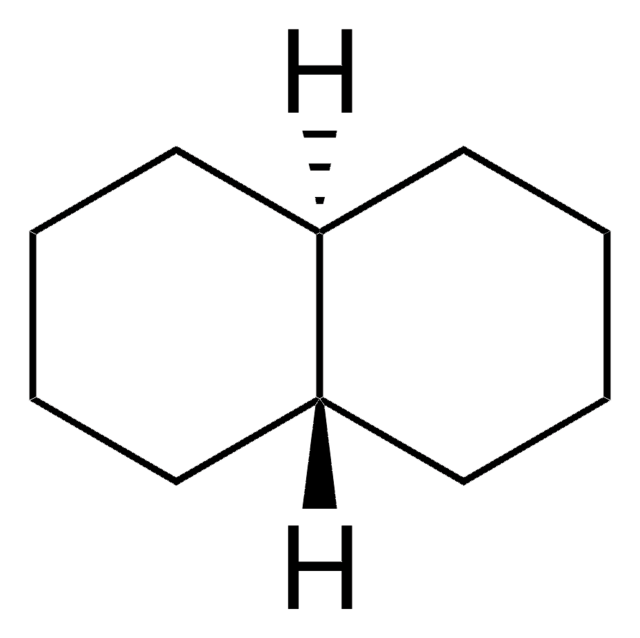8.03101
Decahydronaphthalene
(mixture of cis-and trans isomers) for synthesis
Sinónimos:
Decahydronaphthalene, Decalin
About This Item
Productos recomendados
vapor pressure
1.3 hPa ( 20 °C)
Quality Level
assay
≥99% (GC)
form
liquid
autoignition temp.
255 °C
potency
4170 mg/kg LD50, oral (Rat)
5192 mg/kg LD50, skin (Rabbit)
expl. lim.
0.7-4.9 % (v/v)
kinematic viscosity
<20.5 cSt(25 °C)
bp
189-191 °C/1013 hPa
mp
-40 °C
transition temp
flash point 57 °C
solubility
0.006 g/L (experimental)
density
0.88 g/cm3 at 20 °C
storage temp.
2-30°C
InChI
1S/C10H18/c1-2-6-10-8-4-3-7-9(10)5-1/h9-10H,1-8H2
InChI key
NNBZCPXTIHJBJL-UHFFFAOYSA-N
Categorías relacionadas
Application
- Aerobic biotransformation of decalin (decahydronaphthalene) by Rhodococcus spp.: This study examines the aerobic biodegradation capabilities of Rhodococcus strains with decalin, highlighting potential applications in bioremediation and industrial bioprocesses (Gray et al., 2008).
- Discovery and identification of a series of alkyl decalin isomers in petroleum geological samples.: This research utilizes advanced chromatographic techniques to identify and characterize alkyl decalin isomers in petroleum samples, offering insights into petroleum geochemistry and reservoir characterization (Liu et al., 2015).
- Ultrasound-induced cracking and pyrolysis of some aromatic and naphthenic hydrocarbons.: Explores the effects of ultrasound on the cracking and pyrolysis of hydrocarbons including decahydronaphthalene, offering potential enhancements in chemical processing and analytical methodologies (Cataldo, 2000).
Analysis Note
Density (d 20 °C/ 4 °C): 0.879 - 0.883
Identity (IR): passes test
signalword
Danger
Hazard Classifications
Acute Tox. 3 Inhalation - Aquatic Acute 1 - Aquatic Chronic 1 - Asp. Tox. 1 - Flam. Liq. 3 - Skin Corr. 1B
Storage Class
3 - Flammable liquids
wgk_germany
WGK 3
flash_point_f
134.6 °F - closed cup
flash_point_c
57 °C - closed cup
Certificados de análisis (COA)
Busque Certificados de análisis (COA) introduciendo el número de lote del producto. Los números de lote se encuentran en la etiqueta del producto después de las palabras «Lot» o «Batch»
¿Ya tiene este producto?
Encuentre la documentación para los productos que ha comprado recientemente en la Biblioteca de documentos.
Nuestro equipo de científicos tiene experiencia en todas las áreas de investigación: Ciencias de la vida, Ciencia de los materiales, Síntesis química, Cromatografía, Analítica y muchas otras.
Póngase en contacto con el Servicio técnico










